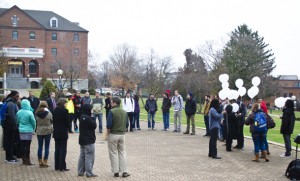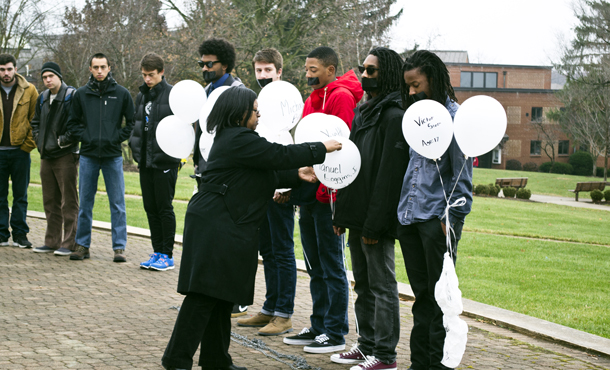About 60 people held a vigil in the heart of Eastern Mennonite University’s campus in early December for black people killed by police in America. Participants attracted by the Black Student Union’s “#StandForFerguson” appeal gathered quietly in the gray mist at Thomas Plaza as club advisor Celeste Thomas invited them to “speak in silence,” showing their solidarity with presence.
The vigil’s name refers to the death of Michael Brown, who was killed in August in Ferguson, Mo. His death and resulting protests in Missouri spurred the BSU to organize a demonstration in solidarity.
A broadcasted gospel song contained these words, “There is power in the name of Jesus to break every chain.” Five students stood in front of the circle, their mouths covered by duct tape, a chain at their feet. In their hands were white balloons, each bearing a name written in black marker.

Undergraduates Kaltuma Hassan and Philip Watson read short eulogies for each person’s name written on the balloons at the Dec. 2 vigil. “One black person is killed every 28 hours in America, whether innocent or guilty,” stated Hassan. “Trayvon Martin, killed February 26, 2012. Seventeen years old, shot in Sanford, Fla., allegedly shot in self defense by George Zimmerman.” As they read through 18 names, Thomas went down the line of balloons, popping each as its name was read. “Dante Parker, killed August 12, 2014. Thirty-six years old. Tased to death. Killed by San Bernadino police department.”
“Being a black, 20-year-old male, I couldn’t help but think that every name that was read aloud could have been me,” said BSU President Londen Wheeler, who was one of those holding balloons. “I hope that the attendees were able to feel the discomfort and the disbelief. I also hope that this was an opportunity for the attendees to see that their voice – although this was a silent protest – against racist police brutality can help make a difference in the nation.”
After the reading, the gospel song was played again, and the five demonstrators picked up the chain at their feet and threw it over the rim of the plaza.
History professor Mark Sawin attended to listen to the BSU and “support them and all my black students and colleagues who are finding ways to speak out.” Acknowledging the privilege that being a straight white male affords him in society, he says “we need to tease apart and closely examine the privilege that allows incidents like this [the shooting of Michael Brown] to happen. There is deep fear in doing this.”

That fear, Sawin explained, is a product of advantaged people who do not recognize their privilege and become defensive in conversations about racial violence. He desires to “create a society where we all work and benefit and live together. I’m horrified by the violence and the fear that permeates our society, so it’s time I start looking at the privilege that creates it.”
Watson, a board member and treasurer of the BSU, said, “I just hope that the vigil opened up a lot of peoples’ eyes and made them aware of what is occurring right in their backyards. The message was clear that this injustice cannot keep continuing.”
Wheeler hopes that the EMU community will start talking about this issue openly; the BSU is working on more educational events about being black in America. “This is something that we can’t keep sugarcoating,” said Wheeler. “Let’s start a conversation.”
Seminary faculty member David Evans said, “Many leaders around the United States have called for a national conversation to deepen our understanding of race and our national history and why conflicts such as these should not surprise us.”
Evans is teaching a class titled “Race and Religion in America.” Held Jan. 4 to March 14, this online, two-credit course is aimed at deepening our understanding of our racial, religious and national identities. Registration is occurring now.
“We will be working to understand how race functions in different periods of time and in relationship to religion and nationalism. Race, religion and nationalism cannot be properly understood without each other. So we will discuss Native American religion, White religion, Mexican Catholicism, Black religion and Jewishness, amongst other identity categories.”
